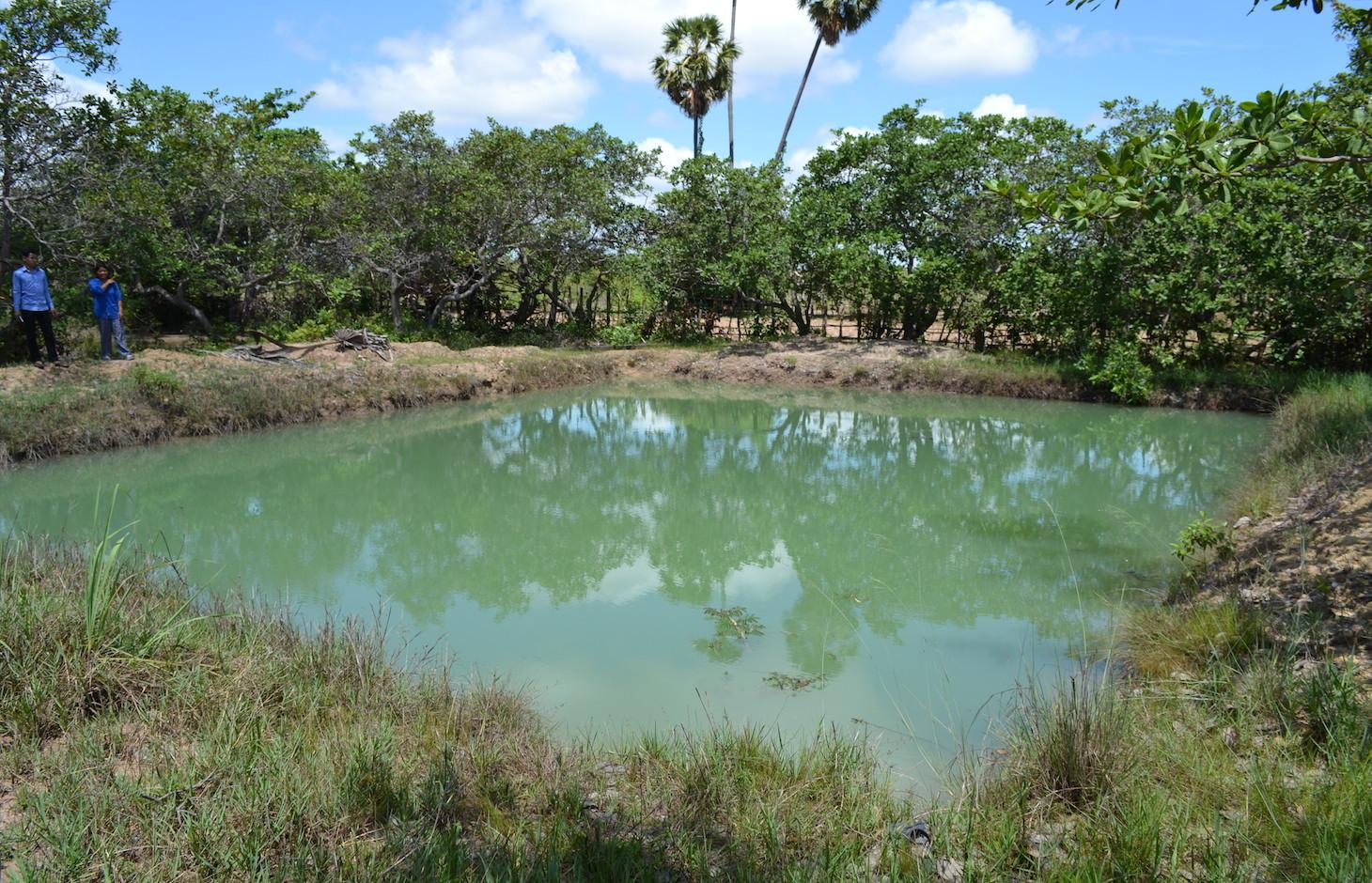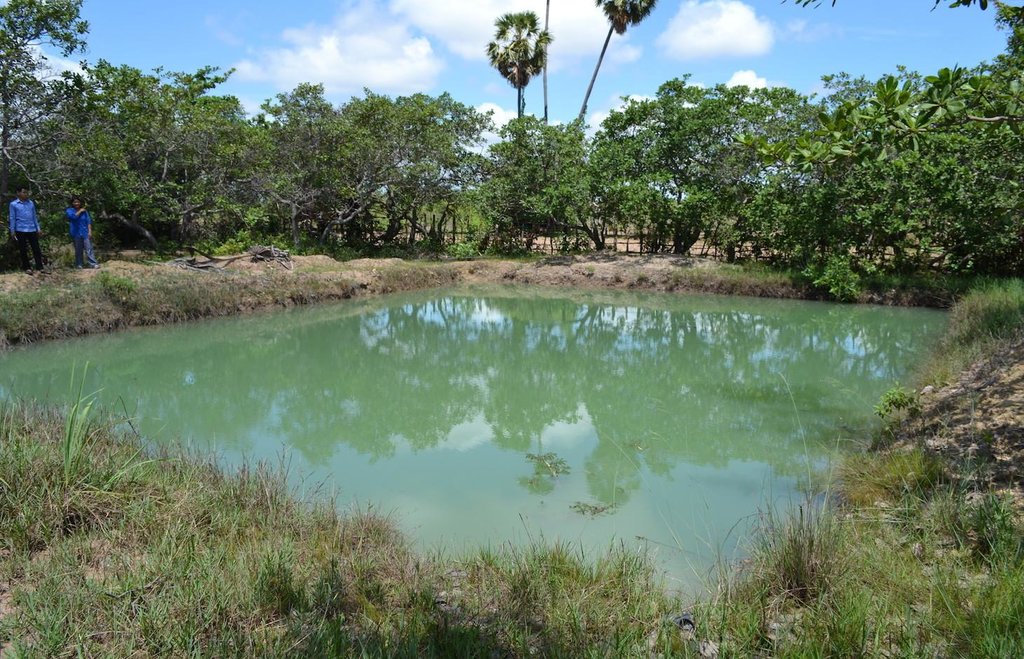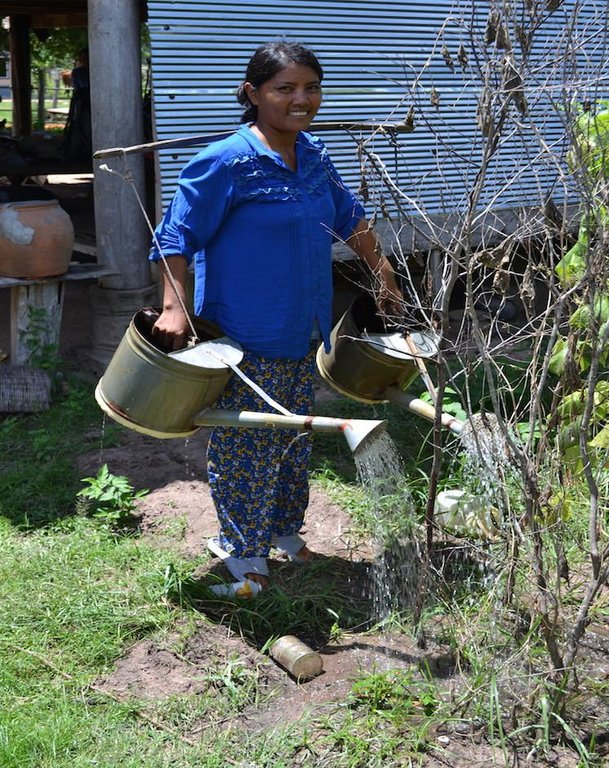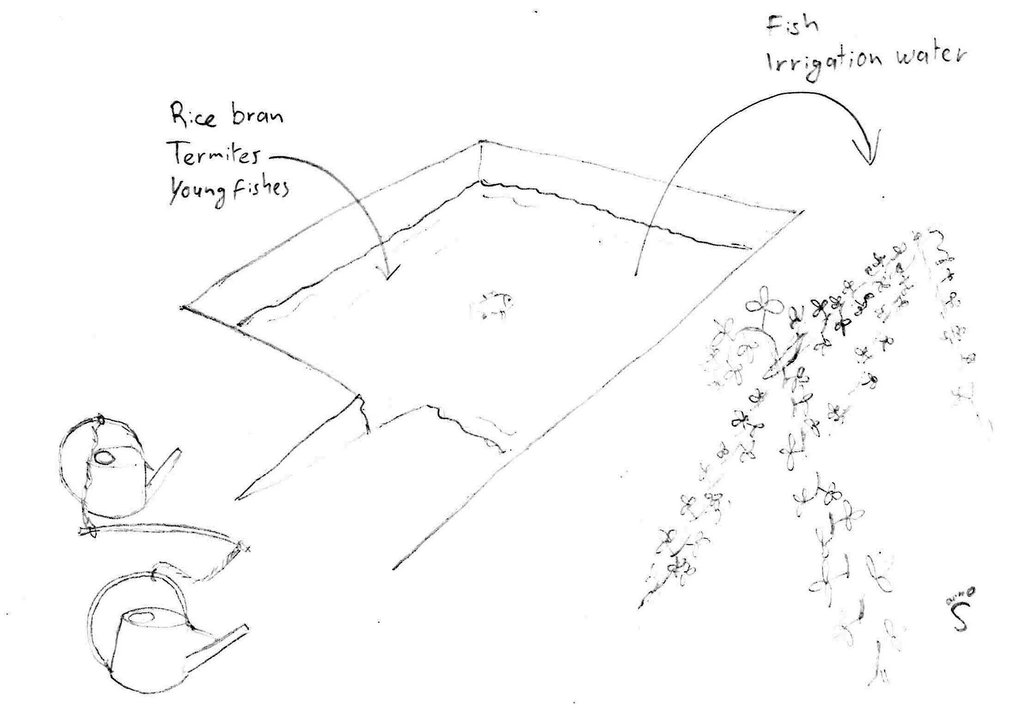Use of household ponds for garden irrigation and fish production. [Камбодж]
- Шинийг нээх:
- Шинэчлэх:
- Мэдээлэл цуглуулсан: Christoph Kaufmann
- Редактор: –
- Хянагчид: Deborah Niggli, Alexandra Gavilano
ការប្រើប្រាស់ស្រះគ្រួសារសំរាប់ស្រោចស្រពច្បារដំណំានឹងការចឹញ្ចឹមត្រី (Khmer)
technologies_1627 - Камбодж
Бүлгүүдийг үзэх
Бүгдийг харуулах Бүгдийг хаах1. Ерөнхий мэдээлэл
1.2 Технологийг үнэлэх, баримтжуулах ажилд хамаарах мэдээлэл өгсөн хүмүүс, байгууллагуудын холбоо барих мэдээлэл
ГТМ мэргэжилтэн :
Khun Lean Hak
SOFDEC/LAREC
Камбодж
1.3 WOCAT-аар баримтжуулсан өгөгдлийг ашиглахтай холбоотой нөхцөл
Эмхэтгэгч болон гол мэдээлэгч хүн(хүмүүс) WOCAT аргачлалаар баримтжуулсан мэдээллийг ашиглахтай холбоотой нөхцлийг хүлээн зөвшөөрсөн.
Тийм
1.4 Технологи тогтвортой гэдгийг баталгаажуулах
Энэ технологи азрын доройтлыг бууруулахад нөлөө үзүүлэхгүй тул газрын тогтвортой менежментийн технологи болж чадахгүй юу?
Үгүй
2. ГТМ Технологийн тодорхойлолт
2.1 Технологийн товч тодорхойлолт
Технологийн тодорхойлолт:
Ponds are used at household level to raise fish as well as to irrigate vegetable gardens and rice seedlings
2.2 Технологийн дэлгэрэнгүй тайлбар
Тодорхойлолт:
Wet-season rice is the predominantly grown crop in the area, but some land users also grow other crops (e.g. sweet potatoes, pumpkins, or peanuts). However, if droughts occur or if the rainfall patterns are erratic, the production can be harmed. Furthermore, due to the lack of water, the land users usually leave their fields bare during the dry season. This results in an increase of wind erosion and in negative impacts on the soil biota due to its exposure to the sun.
In order to tackle these challenges, ponds of 4 m depth (1 m deeper than the groundwater table during the dry season) are used at household level. By building ponds, some fields can be irrigated during the dry season, thus crops can be grown the whole year round. In this case study, sweet potatoes are the main cash crop grown on the irrigated fields during the dry season. The vines can be transplanted to the fields during the beginning of the rainy season, resulting in a better productivity of the crop. Peanuts and cucumbers are other cash crops grown on the irrigated fields.
Additionally, fish are introduced to the pond. These fish, which are caught during fishing for consumption in the flooded rice fields or nearby streams, increase the resilience of the land users: On one hand, they generate additional income and on the other hand, they allow the land users to eat fish the whole year round.
To build the ponds, the land users of this case study benefited from the road construction. The constructer needed soil, and offered to dig a pond for free if they could use the soil. They only dug 2 of the total 4 meters depth of the pond. The land users had to hire someone to dig deeper, as the groundwater level drops below 3 meters soil level during the dry season. The additional benefits from the pond, the fish are introduced as fingerlings when they are caught with the bigger fish. They are fed with termites (around 5 kg of termite nest each day) and with rice bran (1 kg every 3 days). As the pond is only 2 years old, the maintenance activities like digging out the mud did not have to be done yet.
The analysed area is flat (slope < 2%), tropic (dry and wet season), and the soils are mostly sandy or loamy. The soils contain little organic matter, the pH is sinking, the area has been deforested a long time ago and the groundwater table is rather high (1-2 m during the dry season, on the surface during wet season). and the groundwater table is rather high (3 m below soil level during the dry season, on the surface during the wet season).
Due to climate change, the rainfalls are more erratic, temperatures rise and droughts are more recurrent. Rice is the predominant crop grown in the area, since it serves as staple food (mix subsistence and commercial activities). Rice is often grown in monocultures and harvested once a year. Once the rice is harvested (dry season), some farmer release cattle to the paddy fields to eat the straw and weeds.
As an addition to rice, most land users grow vegetable and fruits in small home gardens (subsistence) and complement their income by producing handicrafts or through off farm income / remittances from family members working in other places. The increasing migration rate (the young generation leaves the villages to work in the cities, garment industry or abroad) results in a decrease of available labour force in the area which has detrimental effects on the agricultural activities. Furthermore, the civil war in the 1970s (Khmer Rouge) led to the loss of agricultural knowledge that different NGOs try to re-establish.
2.3 Технологийн гэрэл зураг
2.5 Энэ үнэлгээнд хамрагдсан технологийг хэрэгжүүлсэн улс орон / бүс нутаг / байршил
Улс :
Камбодж
Улс/аймаг/сум:
Kampong Chhnang
Байршлын дэлгэрэнгүй тодорхойлолт:
Roloer pha-er/Bantheay Preal/Tob Srauv (Village)
Технологи өргөн дэлгэрсэн эсхийг тодорхойл:
- газар дээр жигд тархсан
Хэрэв талбайн хэмжээ тодорхойгүй бол талбайн хэмжээг ойролцоогоор тодорхойлно уу.
- < 0.1 км2 (10 га)
Тайлбар:
There are 4 ponds in the village. They are used to irrigate the rice seedlings if the rainy season starts with delay, or if there is a drought after the seeding. In the dry season they are used to irrigate vegetables. Total area of the irrigated fields is around 1 ha.
2.6 Хэрэгжих огноо
Байгуулсан тодорхой оныг мэдэхгүй бол баримжаа хугацааг тодорхойл:
- <10 жилийн өмнө (саяхны)
2.7 Технологийн танилцуулга
Технологийг хэрхэн нэвтрүүлснийг тодорхойл:
- Газар ашиглагчдын санаачилгаар
Тайлбар (төслийн төрөл г.м.):
The pond was built in 2012 by the land user.
3. ГТМ технологийн ангилал
3.1 Технологийн үндсэн зорилго (д)
- Үйлдвэрлэлийг сайжруулах
- Үр ашигтай эдийн засгийн нөлөөг бий болгох
3.2 Технологи хэвтрүүлсэн газрын одоогийн газар ашиглалтын хэлбэр(д)

Тариалангийн газар
- Нэг наст үр тариа
- rice
Нэг жил дэх ургамал ургах улирлын тоо:
- 1
Тодорхойлно уу:
Longest growing period in days: 210, Longest growing period from month to month: June to December

Усан зам, усан сан, ус намгархаг газар
- Цөөрөм, далан
Тайлбар:
Major land use problems (compiler’s opinion): Low soil fertility, lack of water during the dry season, more recurrent droughts due to climate change, leaving the fields bare after the rice is harvested which results in higher erosion and in the loss of soil biota, predominance of rice monocultures, low technical knowledge of the land users about land conservation measures.
Major land use problems (land users’ perception): Droughts, especially in the early rainy season. Rice seedlings need a reliable source of water.
3.4 Усан хангамж
Технологи хэрэгжүүлсэн газрын усан хангамж:
- Байгалийн/усалгаа хосолсон
3.5 Технологи ГТМ-ийн аль бүлэгт хамаарах
- Усжуулалтын менежмент (усан хангамж, ус зайлуулалт зэрэг.)
- Гадаргын усны менежмент (булаг шанд, гол, нуур, далай)
- зөгийн аж ахуй, засагны аж ахуй, тахиа үржүүлэг, туулай үржүүлэг, торгоны хүүхэлдэйн аж ахуй г.м.
3.6 Технологийг бүрдүүлэх ГТМ арга хэмжээ

Барилга байгууламжийн арга хэмжээ
- S4: Шаталсан шуудуу, нүх, хэвгий
3.7 Технологийн шийдвэрлэсэн газрын доройтлын үндсэн төрлүүд

Биологийн доройтол
- Bq: Хэмжээ/ Биомасс буурах

Усны доройтол
- Ha: Хуурайшилт
Тайлбар:
Main causes of degradation: crop management (annual, perennial, tree/shrub) (Mainly annuals with high water demand are planted.)
Secondary causes of degradation: soil management (Ploughing of soil, lack of water retention.), change in temperature (More hot days, drying up the soil.), change of seasonal rainfall (Beginning of rain season is unpredictable.), droughts (.Especially detrimental in the beginning of the monsoon.), education, access to knowledge and support services (A lot of agricultural knowledge was lost during the Khmer Rouge Regime.)
3.8 Газрын доройтлоос урьдчилан сэргийлэх, сааруулах ба нөхөн сэргээх
Газрын доройтолтой холбоотойгоор Технологи ямар зорилго тавьсан болохыг тодорхойл:
- Газрын доройтлоос урьдчилан сэргийлэх
- Газрын доройтлыг багасгах сааруулах
4. Техникийн нөхцөл, хэрэгжилтийн үйл ажиллагаа, материал ба зардал
4.1 Технологийн техникийн зураг
Техник тодорхойлолт (техник зурагтай уялдана):
Pond used for irrigation as well as for fish production. In this case two watering cans are used, with a stick between them to transfer the weight to the shoulders.
Kampong Chhnang
Date: 2014
Technical knowledge required for field staff / advisors: low (No field staff was involved.)
Technical knowledge required for land users: low
Main technical functions: water harvesting / increase water supply
Dam/ pan/ pond
Depth of ditches/pits/dams (m): 4
Width of ditches/pits/dams (m): 12
Length of ditches/pits/dams (m): 18
Specification of dams/ pans/ ponds: Capacity 800m3
Catchment area: ground waterm2
Зохиогч:
Stefan Graf, Switzerland
4.2 Материал болон зардалд хамаарах ерөнхий мэдээлэл
Хөлсний ажилчны нэг өрдийн ажлын хөлсийг тодорхойл:
5.00
4.3 Байгуулах үйл ажиллагаа
| Үйл ажиллагаа | Хугацаа (улирал) | |
|---|---|---|
| 1. | Dig the first 2 m | Dry season |
| 2. | Dig the last 2 m | Dry season |
4.4 Байгуулалтад шаардагдах зардал ба материал
| Хөрөнгө оруулалтыг дурьдана уу | Хэмжих нэгж | Тоо хэмжээ | Нэгжийн өртөг | Материал бүрийн нийт өртөг | % газар ашиглачаас гарсан зардал | |
|---|---|---|---|---|---|---|
| Тоног төхөөрөмж | machine use | 1.0 | 100.0 | 100.0 | 50.0 | |
| Технологи бий болгох нийт үнэ өртөг | 100.0 | |||||
| Технологи бий болгох нийт үнэ өртөг, ам.доллар | 100.0 | |||||
4.5 Засвар үйлчилгээ / давтагдах үйл ажиллагаа
| Үйл ажиллагаа | Хугацаа/ давтамж | |
|---|---|---|
| 1. | Catch and select fingerlings in the rice fields and canals. | Every year during wet season |
| 2. | Select fingerlings from catch in local streams to add in pond. | Every year during dry season. |
| 3. | Dig out the pond. Not yet done, as the pond is still new. | |
| 4. | Feed the fish with termites and rice bran. | Regularly. |
| 5. | Fertilize the pond | Yearly in the beginning of the wet season |
4.6 Засвар үйлчилгээ / урсгал үйл ажиллагаанд шаардагдах зардал ба материал (жилээр)
| Хөрөнгө оруулалтыг дурьдана уу | Хэмжих нэгж | Тоо хэмжээ | Нэгжийн өртөг | Материал бүрийн нийт өртөг | % газар ашиглачаас гарсан зардал | |
|---|---|---|---|---|---|---|
| Хөдөлмөр эрхлэлт | labour | 1.0 | 134.5 | 134.5 | 100.0 | |
| Технологийг арчилах тордоход шаардагдах нийт үнэ өртөг | 134.5 | |||||
| Технологи сайжруулах нийт үнэ өртөг, ам.доллар | 134.5 | |||||
Тайлбар:
Machinery/ tools: Fishing traps. 1 costs around 1.2 US$. Fishing net, around 6.5 US$. They had them anyway to catch fish for consumption.
The costs were calculated for one pond, as the area is not relevant.
4.7 Зардалд нөлөөлж байгаа хамгийн чухал хүчин зүйл
Өртөг зардлыг тодорхойлох гол хүчин зүйлсийг дурьдана уу:
The most expensive factor is the availability of an excavator to dig the pond.
5. Хүн, байгалийн хүрээлэн буй орчин
5.1 Уур амьсгал
Жилийн нийлбэр хур тундас
- <250 мм
- 251-500 мм
- 501-750 мм
- 751-1,000 мм
- 1,001-1,500 мм
- 1,501-2,000 мм
- 2,001-3,000 мм
- 3,001-4,000 мм
- > 4,000 мм
Хур тунадасны талаархи тодорхойлолт/ тайлбар:
1486.45 mm (2013) in Kampong Chhnang
Агро-уур амьсгалын бүс
- Хагас чийглэг
Thermal climate class: tropics. 27-35°C
5.2 Байрзүйн зураг
Дундаж налуу:
- Тэгш (0-2 %)
- Бага зэрэг хэвгий (3-5 %)
- Дунд зэрэг хэвгий (6-10 % )
- Долгиорхог (11-15 %)
- Толгодорхог (16-30 %)
- Эгц налуу (31-60 % )
- Огцом эгц налуу (>60 %)
Гадаргын хэлбэр:
- Тэгш өндөрлөг/тэгш тал
- Зоо, хяр
- Уулын энгэр, хажуу
- Ухаа, гүвээ, дов толгод
- Уулын бэл
- Хөндий, хоолой, нам хотос
Өндөршлийн бүс:
- 0-100 м д.т.д
- 101-500 м д.т.д
- 501-1,000 м д.т.д
- 1,001-1,500 м д.т.д
- 1,501-2,000 м д.т.д
- 2,001-2,500 м д.т.д
- 2,501-3,000 м д.т.д
- 3,001-4,000 м д.т.д
- > 4,000 м д.т.д
5.3 Хөрс
Хөрсний дундаж зузаан:
- Маш нимгэн (0-20 см)
- Нимгэн (21-50 см)
- Дунд зэрэг зузаан (51-80 см)
- Зузаан (81-120 cм)
- Маш зузаан (>120 cм)
Хөрсний бүтэц (өнгөн хөрс):
- Сийрэг/хөнгөн (элсэрхэг)
- Дунд зэрэг (шавранцар)
Өнгөн хөрсний органик нэгдэл:
- Дунд (1-3 % )
- Бага (<1 % )
5.4 Усны хүртээм ба чанар
Хөрсний усны гүн:
< 5 м
Гадаргын усны хүртээмж:
Муу/огт байхгүй
Усны чанар (цэвэрлээгүй):
Муу чанарын ундны ус (цэвэршүүлэх шаардлагатай)
Усны чанар, нөөцийн талаархи тайлбар ба бусад тодорхойлолт:
Ground water table: during dry season
Availability of surface water: during dry season
5.5 Биологийн төрөл зүйл
Зүйлийн олон янз байдал:
- Дунд зэрэг
5.6 Технологи нэвтрүүлсэн газар ашиглагчидын онцлог шинж
Үйлдвэрлэлийн системийн зах зээлийн чиг баримжаа:
- холимог (амьжиргаа ба худалдаанд)
Фермээс гадуурх орлого:
- Нийт орлогын % 10-50 хувь
Чинээлэг байдлыг харьцангуй түвшин:
- Дундаж
- Чинээлэг
Хувь хүн эсвэл бүлэг:
- Хувь хүн / өрх
Механикжилтын түвшин:
- Хүнд хүчир ажил
- Механикжсан / мотортой
Хүйс:
- Эмэгтэй
- Эрэгтэй
Газар ашиглагчдын бусад шаардлагатай шинж чанарыг тодорхойл:
Land users applying the Technology are mainly Leaders / privileged
Population density: 10-50 persons/km2
Annual population growth: 0.5% - 1%
Off-farm income specification: Handicraft, remittances, factory work
5.7 Технологи нэвтрүүлэхэд газар ашиглагчийн ашигласан газрын дундаж талбай
- < 0.5 га
- 0.5-1 га
- 1-2 га
- 2-5 га
- 5-15 га
- 15-50 га
- 50-100 га
- 100-500 га
- 500-1,000 га
- 1,000-10,000 га
- > 10,000 га
Энэ нь жижиг, дунд, том оворт тооцогдох уу (орон нутгийн чиг баримжаагаар)?
- Бага-хэмжээний
5.8 Газар эзэмшил, газар ашиглах эрх, ус ашиглах эрх
Газар өмчлөл:
- Нэгдэл/ тосгон
- Хувь хүн, тодорхой цол эргэмгүй
Газар ашиглах эрх:
- Нэгдлийн хэлбэрээр (зохион байгуулалттай)
- Хувь хүн
Ус ашиглах эрх:
- Нээлттэй хүртэх (зохион байгуулалтгүй)
Тайлбар:
Land users have a title that is not recognized by the state.
5.9 Дэд бүтэц, үйлчилгээний хүртээмж
эрүүл мэнд:
- Ядуу
- Дунд зэргийн
- Сайн
боловсрол:
- Ядуу
- Дунд зэргийн
- Сайн
техник дэмжлэг:
- Ядуу
- Дунд зэргийн
- Сайн
хөдөлмөр эрхлэлт (жишээ нь, ХАА-аас өөр):
- Ядуу
- Дунд зэргийн
- Сайн
зах зээл:
- Ядуу
- Дунд зэргийн
- Сайн
эрчим хүч:
- Ядуу
- Дунд зэргийн
- Сайн
зам ба тээвэр:
- Ядуу
- Дунд зэргийн
- Сайн
ундны ус ба ариутгал:
- Ядуу
- Дунд зэргийн
- Сайн
санхүүгийн үйлчилгээ:
- Ядуу
- Дунд зэргийн
- Сайн
6. Үр нөлөө ба дүгнэлт
6.1 Технологийн талбай дахь үр нөлөө
Нийгэм-эдийн засгийн үр нөлөө
Үйлдвэрлэл
Газар тариалангийн үйлдвэрлэл
малын бүтээмж
Тайлбар/ тодорхой дурьдах:
Fish
үйлдвэрлэл зогсох эрсдэл
олон янз бүтээгдэхүүн
Үйлдвэрлэлийн газар
Орлого, зарлага
тариалангийн газрын орлого
орлогын олон янз эх үүсвэр
Нийгэм-соёлын үр нөлөө
хүнсний аюулгүй байдал/ өөрийгөө хангах
contribution to human well-being
Тайлбар/ тодорхой дурьдах:
Ponds allow the land user to grow crops the whole year round. Furthermore, there are fish in the pond which provide a reliable source of food.
Экологийн үр нөлөө
Усны эргэлт/ илүүдэл
усны хэмжээ
Хөрс
хөрсний чийг
6.3 Технологийн уур амьсгалын өөрчлөлт ба Уур амьсгалаас хамаарах аюул/гамшигт үзэгдэлд өртөх байдал ба эмзэг байдал (газар ашиглагч нарын дүгнэлтээр)
Уур амьсгалын аажим өөрчлөлт
Уур амьсгалын аажим өөрчлөлт
| Улирал | Өсөх эсвэл буурах | Технологи түүний нөлөөг хэрхэн бууруулж байна? | |
|---|---|---|---|
| Жилийн дундаж температур | Өсөлт | Сайн |
Уур амьсгалаас хамаарах аюулууд (гамшигууд)
Цаг уурын гамшигууд
| Технологи түүний нөлөөг хэрхэн бууруулж байна? | |
|---|---|
| Орон нутгийн аадар бороо | Сайн |
| Орон нутгийн салхин шуурга | Сайн |
Уур амьсгалын гамшигууд
| Технологи түүний нөлөөг хэрхэн бууруулж байна? | |
|---|---|
| Ган гачиг | Сайн |
Гидрологийн гамшиг
| Технологи түүний нөлөөг хэрхэн бууруулж байна? | |
|---|---|
| усны үер (гол) | Сайн биш |
Бусад уур амьсгалд хамаарах үр дагаварууд
Бусад уур амьсгалд хамаарах үр дагаварууд
| Технологи түүний нөлөөг хэрхэн бууруулж байна? | |
|---|---|
| Ургалтын хугацаа багасах | Сайн |
6.4 Зардал ба үр ашгийн шинжилгээ
Үр ашгийг барилга байгууламжийн зардалтай (газар ашиглагчдын үзэл бодлоор) хэрхэн харьцуулах вэ?
Богино хугацаанд эргэн төлөгдөх байдал:
Бага зэрэг сөрөг
Урт хугацаанд эргэн төлөгдөх байдал:
Эерэг
Үр ашгийг засвар үйлчилгээ/ урсгал зардалтай (газар ашиглагчдын үзэл бодлоор) хэрхэн харьцуулах вэ?
Богино хугацаанд эргэн төлөгдөх байдал:
Эерэг
Урт хугацаанд эргэн төлөгдөх байдал:
Эерэг
6.5 Технологи нутагшуулах
- > 50%
Технологийг өөрийн талбайд нэвтрүүлсэн бусад иргэдээс хэд нь үүнийг өөрийн хүчээр, өөрөөр хэлбэл ямар нэг материал, техникийн дэмжлэг, төлбөр авалгүй хийсэн бэ?
- 0-10%
Тайлбар:
100% of land user families have adopted the Technology with external material support
The farmer from this case study got a kind of subsidy: For the construction of the nearby road, the builders needed soil. They offered to dig a pond if they could get the soil. They only dug 2 of the 4 meters of the pond debt, the farmer had to hire somebody to dig out the rest. The other land users who have implemented the ponds also collaborated with construction workers to dig the pond. The lack of money hinders most of the farmers to implement the technology.
6.7 Технологийн давуу тал/боломжууд
| Газар ашиглагчдын тодорхойлсон давуу тал/боломжууд |
|---|
| Water available in the dry season for cash crops. The rice fields can be used in the dry season instead of being left bare. |
| The rice seedlings can be irrigated during the early wet season in case of drought or erratic rainfall. |
| Diversification of diet and income: fish is available the whole year round. |
| Эмхэтгэгч, бусад мэдээлэл өгсөн хүмүүсийн өнцгөөс тодорхойлсон давуу тал/боломжууд |
|---|
| As parts of the rice fields are irrigated and planted during the dry season, there is less wind erosion and the soil is improving. |
| The fish feed (rice bran and termites) consists of local resources. |
6.8 Технологийн дутагдалтай/сул тал/аюул болон тэдгээрийн хэрхэн даван туулах арга замууд
| Газар ашиглагч нарын тодорхойлсон сул тал/ дутагдал/ эрсдэл | Тэдгээрийг хэрхэн даван туулах вэ? |
|---|---|
| If flooded the fish can go away. | Nets need to be put around the pond in the wet season. This farmer already does this. |
| Fingerlings are difficult to find. | Find a fish breeder, or breed fish by themselves. Creating niches in the ponds for the offspring, where the bigger fish do not eat it, could do the breeding. |
| Эмхэтгэгч, бусад мэдээлэл өгсөн хүмүүсийн өнцгөөс тодорхойлсон сул тал/ дутагдал/ эрсдэл | Тэдгээрийг хэрхэн даван туулах вэ? |
|---|---|
| Fingerlings of different sizes and species are put into the pond. The bigger eat the smaller. | Fence off areas for bigger fish, and move the big fish there so they cannot catch the smaller. Or build structures where the smaller fish can hide. |
7. Ном зүй ба холбоосууд
7.1 Мэдээллийн аргууд / эх сурвалжууд
- Хээрийн уулзалт, судалгаа
- Газар ашиглагчтай хийсэн ярилцлага
Мэдээллийг хэзээ (газар дээр нь) цуглуулсан бэ?
07/07/2014
7.2 Хүртээмжтэй ном, бүтээлийн ишлэл
Гарчиг, зохиогч, он, ISBN:
Konhel Pith, Local Agricultural Research and Extension Centre LAREC in Kampong Chhnang; khonhel@gmail.com
Холбоос ба модулууд
Бүгдийг харуулах Бүгдийг хаахХолбоосууд
Холбоос байхгүй байна
Модулууд
Модуль байхгүй байна





